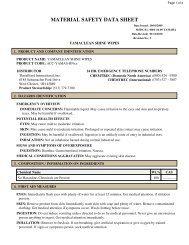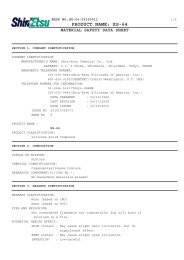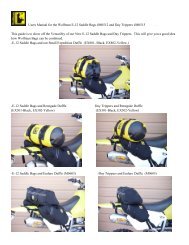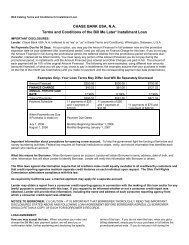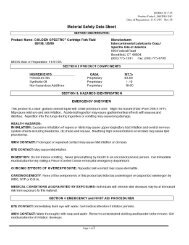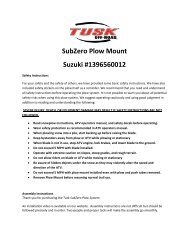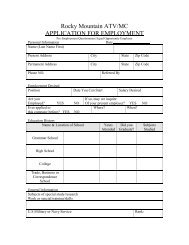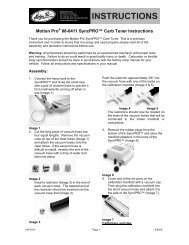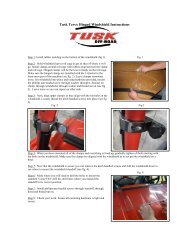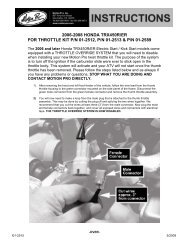MATERIAL SAFETY DATA SHEET - Rocky Mountain ATV/MC
MATERIAL SAFETY DATA SHEET - Rocky Mountain ATV/MC
MATERIAL SAFETY DATA SHEET - Rocky Mountain ATV/MC
Create successful ePaper yourself
Turn your PDF publications into a flip-book with our unique Google optimized e-Paper software.
Page 2 of 5<br />
contaminated clothing and shoes. Get medical attention immediately. Thoroughly wash or discard clothing and shoes<br />
before reuse.<br />
INGESTION: If swallowed, rinse mouth well with water if person is conscious. Do not induce vomiting unless directed<br />
to do so by medical personnel. Get medical attention immediately.<br />
INHALATION: Remove to fresh air. If not breathing, give artificial respiration or give oxygen by trained personnel. If<br />
signs or symptoms persist, seek medical attention.<br />
NOTES TO PHYSICIAN: This product contains methanol which can cause intoxication and CNS depression. Methanol<br />
is metabolized to formic acid and formaldehyde. These metabolites can cause metabolic acidosis, visual disturbances<br />
and blindness. Since metabolism is required for these toxic symptoms, their onset may be delayed from 6 to 30 hours<br />
following ingestion. Ethanol competes for the same metabolic pathway and has been used to prevent methanol<br />
metabolism. Ethanol administration is indicated in symptomatic patients or at blood methanol concentrations above 20<br />
ug/dl. Methanol is effectively removed by hemodialysis.<br />
5. FIRE FIGHTING MEASURES<br />
FLASHPOINT AND METHOD: 11°C (51.8°F) Closed Cup<br />
Notes: Lowest known value.<br />
AUTOIGNITION TEMPERATURE: > 200°C (392°F)<br />
FLAMMABLE CLASS: Flammable.<br />
EXTINGUISHING MEDIA: Use dry chemical powder, alcohol foam, or carbon dioxide.<br />
HAZARDOUS COMBUSTION PRODUCTS: Carbon oxides. May emit other toxic fumes under fire conditions.<br />
OTHER CONSIDERATIONS: Vapor may travel considerable distance to source of ignition and flash back.<br />
EXPLOSION HAZARDS: High temperatures or fire may cause container to explode. Use water spray to cool fire<br />
exposed containers.<br />
FIRE FIGHTING PROCEDURES: As in any fire, wear self-contained breathing apparatus pressure-demand,<br />
(MSHA/NIOSH approved or equivalent) and full protective gear.<br />
6. ACCIDENTAL RELEASE MEASURES<br />
SMALL SPILL: Eliminate all ignition sources. Absorb with an inert material and place in an appropriate waste disposal<br />
container.<br />
LARGE SPILL: Extinguish all sources of ignition. Stop spill or leak at source. Dike if necessary. Absorb with an inert<br />
material and place in an appropriate waste disposal container. Use non-sparking tools.<br />
RELEASE NOTES: Keep spilled material from entering storm drains, sewers, or other environmental mediums.<br />
COMMENTS: Disposal of clean-up materials may be governmentally regulated. Observe all applicable local, state, and<br />
federal waste management regulations.<br />
7. HANDLING AND STORAGE<br />
HANDLING: Avoid contact with eyes and skin. Wear appropriate personal protection. Wash thoroughly after handling.<br />
Empty containers may retain product residue and flammable vapors. Keep away from heat, sparks, and flame. Do not<br />
cut, puncture, or weld on or near the empty container.<br />
STORAGE: Keep container closed when not in use. Store in a cool, dry, well-ventilated area. Store and use away from<br />
heat, sparks, open flames, or other ignition sources.<br />
8. EXPOSURE CONTROLS / PERSONAL PROTECTION



